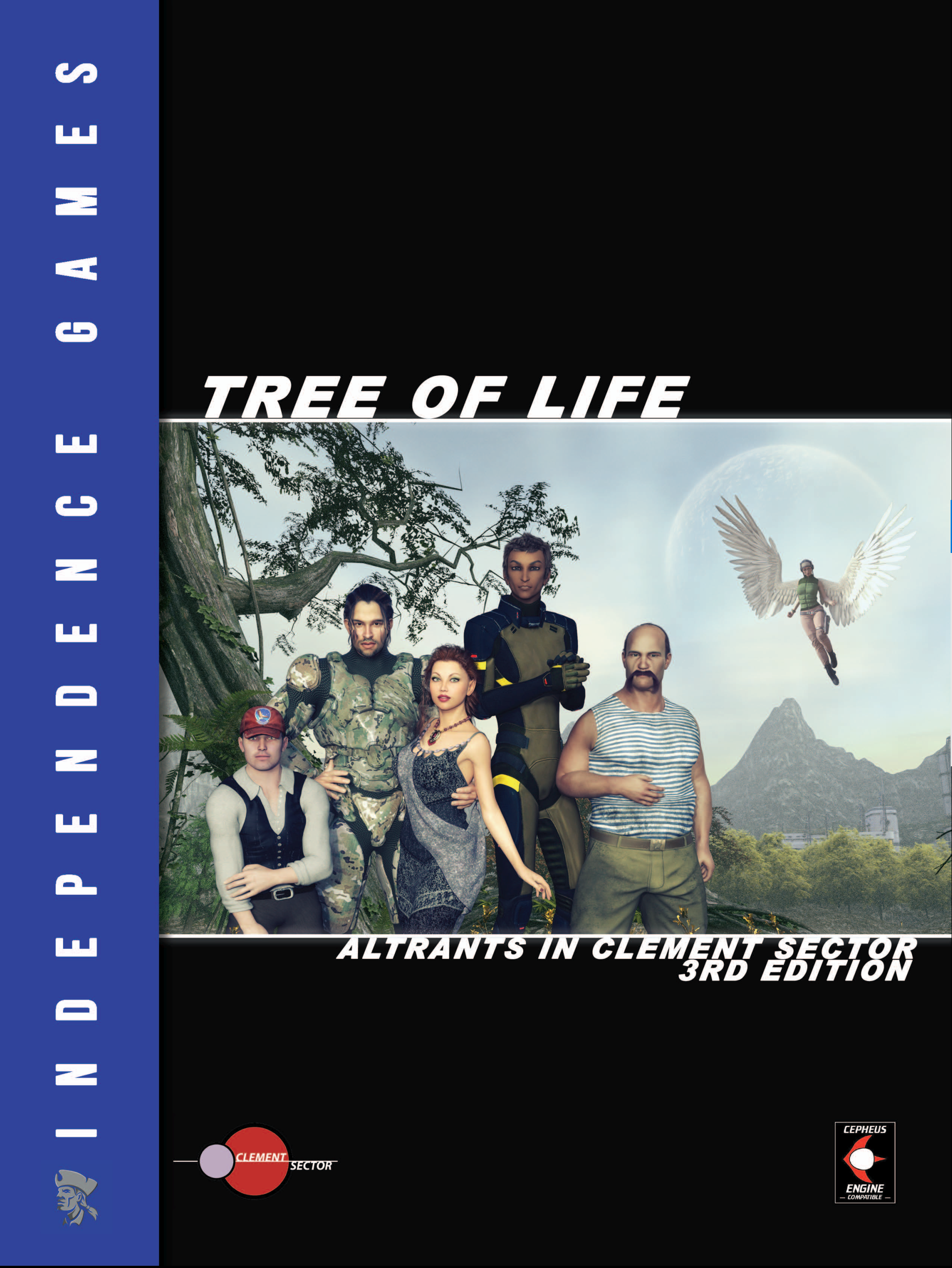Tree of Life: Altrants in Clement Sector
This article originally appeared in the July/August 2023 issue.
 Tree
of Life. John Watts.
Tree
of Life. John Watts.
Independence Games https://independencerpgs.com
84pp. PDF, Hardbound, Softcover
US$34.99(H+P)24.99(S+P)9.99(P)
UKú27.73(H+P)19.81(S+P)7.92(P)
When I read through Tree of Life, I thought a lot of the material was familiar. On reflection, though, perhaps it shouldn’t have been surprising; if you have the technology to create uplifts as described in Wondrous Menagerie (see my review), how can you not have the technology to create altrants? Ultimately, the only difference is your base material – animals for uplifts, humans for altrants. Once you’ve made that first step, it would be inevitable that the same questions – ethical, economic, whatever – would arise regardless of your base material, and it would be difficult to justify one and oppose the other.
Tree of Life represents for altrants what Wondrous Menagerie does for uplifts – it’s a guide to what altrants are, how they’re treated, how to create them as characters and play them, and so on.
The book starts with an overview of what altrants are, and the history of their creation. This section distinguishes “altrants” (humans who are genetically altered from birth) from “altered humans” (humans who were born as ‘baseline’ humans, but have had changes made to themselves). It goes on to describe the way early altrants were used, and the different types of altrant that were developed for different purposes.
Given that history repeats – or, in some ‘takes’ on the phenomenon, it doesn’t repeat, but it echos and rhymes – it shouldn’t be surprising that altrant slavery was common, and so were altrant rebellions.
Following the historical overview is a subsector-by-subsector and world-by-world overview of the current status of altrants in Clement Sector. This can range from full equality through various levels of discrimination and bigotry to outright slavery.
Altrants may be classified by generation, by type of alteration, and by the parents’ altrant nature. The latter distinguishes between altrants whose parents were both the same type of altrant, those whose parents were both altrants but of different types (compounds), and those who had one baseline-human parent (hybrids). A ‘first generation’ altrant is one whose creation is not by sexual reproduction between altrants, but by laboratory work. A ‘second generation’ altrant is one whose parents were both ‘first generation’ altrants of the same type, a ‘third generation’ altrant is one whose parents were both ‘second generation’ altrants of the same type, and so on. This volume does not define what generation an altrant is if the parents were altrants of the same type but different generations.
The altrant’s type is defined by the package of alterations and the purpose of creation – for example, the Achilles is optimized for combat; the Aquan is amphibious, and so on. This book describes ten types of altrant, ranging from adaptations to extremes of environment to specific tasks (including entertainment). Not all altrants can reproduce, and not all that can can reproduce outside their type or with baseline humans.
Following the overview of altrant types is a list of specific alterations, which can be applied to baseline humans or (in some cases) to altrants. Most are functional in some way, but a few are only cosmetic. Each has a cost –in money, in time, and in changes to attributes (including SOC DM for visible alterations under some circumstances).
Player-characters can be altrants, and there are rules for determining altrant status (purebred [including generation], hybrid, compound) and which advantages/disadvantages of the altrant form are available to the character. Because altrant slavery and discrimination exist on some worlds in the setting, the main Clement Sector character generation process is modified to accommodate these social situations, including a full Altrant Slave career. Where altrants aren’t free, they’re often assigned names, and some sample names for altrants are provided, along with the reasons that the names fall into certain patterns.
With the wide range of opinion on what the legal status of altrants should be, it shouldn’t be surprising that organisations – both advocacy- and ‘action’-based – will form to push for specific goals with respect to altrant status. A few are described, and are perhaps good examples for developing one’s own.
Finally, one new skill (Altrant Psychology) is presented; this skill is aimed at dealing with the special psychological issues that altrants experience.
Overall, a worthwhile purchase – one that should be considered mandatory if playing in the Clement Sector setting, but still useful if one wanted to come up with a human minor race for the Third Imperium setting.
 Freelance
Traveller
Freelance
Traveller